PROTECT YOUR DNA WITH QUANTUM TECHNOLOGY
Orgo-Life the new way to the future Advertising by Adpathway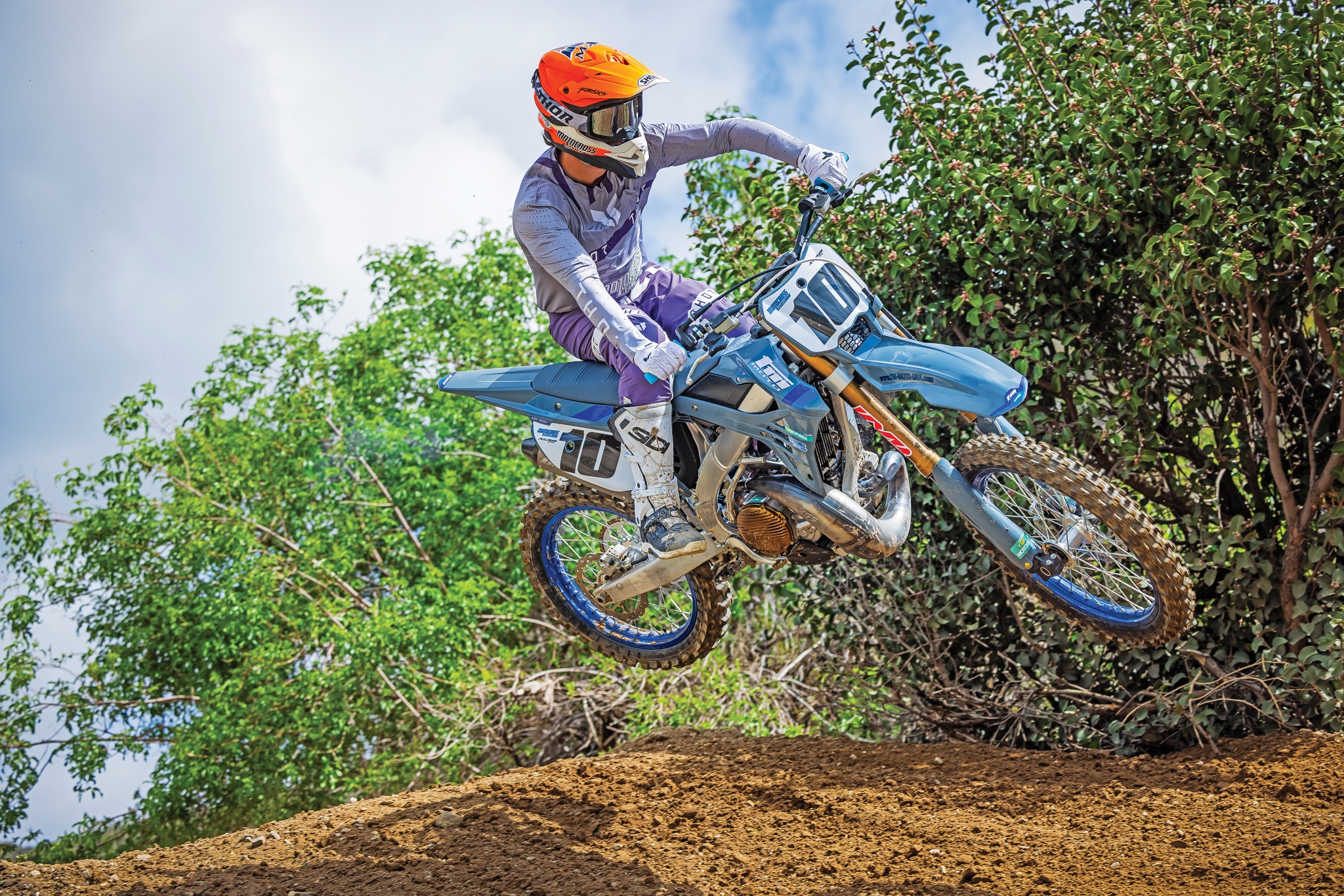 THE GEAR: Jersey: Thor MX Prime, Pants: Thor MX Prime, Helmet: Shoei VFX-Evo, Goggles: Thor MX Activate, Boots: Sidi Crossair.
THE GEAR: Jersey: Thor MX Prime, Pants: Thor MX Prime, Helmet: Shoei VFX-Evo, Goggles: Thor MX Activate, Boots: Sidi Crossair.
Q: FIRST AND FOREMOST, IS THE 2025 TM 300MX BETTER THAN THE 2024 MODEL?
A: To be honest, we can’t say anything about last year’s bike. The exotic Italian TM motorcycles have been missing from our fleet for the last three years. Ralf Schmidt was the longtime importer for TM USA, and he spent many long days at the track with our test riders, helping us get comfortable on the trick Italian TMs.
When Ralf and TM Italy parted ways, the phone lines between MXA and TM went cold, and TM was without a U.S. importer for a few years. Finally, Cam Mitchell and 71 Powersports stepped up to import TMs to the U.S. again. Cam has been the Canadian TM importer for a while now, and he recently expanded into the American market, working with many of the same dealerships that previously sold TMs under Ralf.
Q: WHAT’S NEW ON THE 2025 TM 300MX TWO-STROKE?
A: Since we last tested the TM 300MX in 2019, the bike gained a new frame in 2022, new hubs, new radiators, new handlebars, multiple ECU updates, a new exhaust from HGS and a new air filter. Specifically for 2025, the TM 300MX received updated suspension settings front and rear to make it softer and plusher. The frame was updated again. The clutch was updated, and the plastics are now grey.
The 2025 TM 300MX two-stroke comes with an aluminum frame and an electric-starting, carbureted, 300cc two-stroke engine, equipped with an electronic power valve and a VForce3 reed valve. The exhaust is made by HGS, and the silencer has a plastic end cap that looks like it’s made out of carbon fiber. The coil-spring forks are from Kayaba, and the shock is made by TM. It has a Brembo hydraulic clutch and Brembo front brake with a Nissin rear brake. It comes with a Regina GPX O-ring chain, Bridgestone Battlecross X31 tires, Takasago Excel rims with VPX hubs (still a nine-bolt rear sprocket), a Twin Air filter and lots of Allen bolts throughout the whole machine.
Q: WHERE DOES THE TM 300MX TWO-STROKE FIT INTO TM’S MODEL RANGE?
A: Because TM is a small boutique brand, only producing about 1500 bikes a year, they can diversify their lineup by offering all kinds of different options. In the 300cc two-stroke category alone, TM offers two motocross models (one carbureted and one fuel-injected), and they offer the same two platforms in enduro models. The 300cc two-stroke is the most popular bike TM currently makes, and it’s the fuel-injected Enduro version that they sell the most. TM uses the same frame for its 300MX and EN300 (Enduro) models. The frame has mounts for a kickstand and a handlebar lock; however, it’s different from the four-stroke TMs, which have different frames and subframes to fit the rear-mounted fuel tank.
Another benefit to buying a bike from a smaller manufacturer is that you can order a customized bike from the factory. The TM 300MX we tested retails for $10,395 in its stock form, but ours was upgraded from the factory. It came with Kayaba A-kit forks with Kashima-coated uppers and DLC-coated lowers ($925), a kickstarter in addition to the electric starter ($300), rubber-mounted handlebar clamps and top triple clamps ($185), and a CNC-machined billet clutch and ignition covers ($570). Our test TM 300MX has an MSRP of $12,375. Plus, if you’re an off-roader, you can order an oversized 3.2-gallon tank for $265, an electric cooling fan for $130 and a six-speed transmission for $265. If you want the throwback pink-edition livery, that’s an extra $450, or the red-edition bike goes for an extra $190. TMs are expensive, but that is the price you pay to own a bike made in limited quantities.
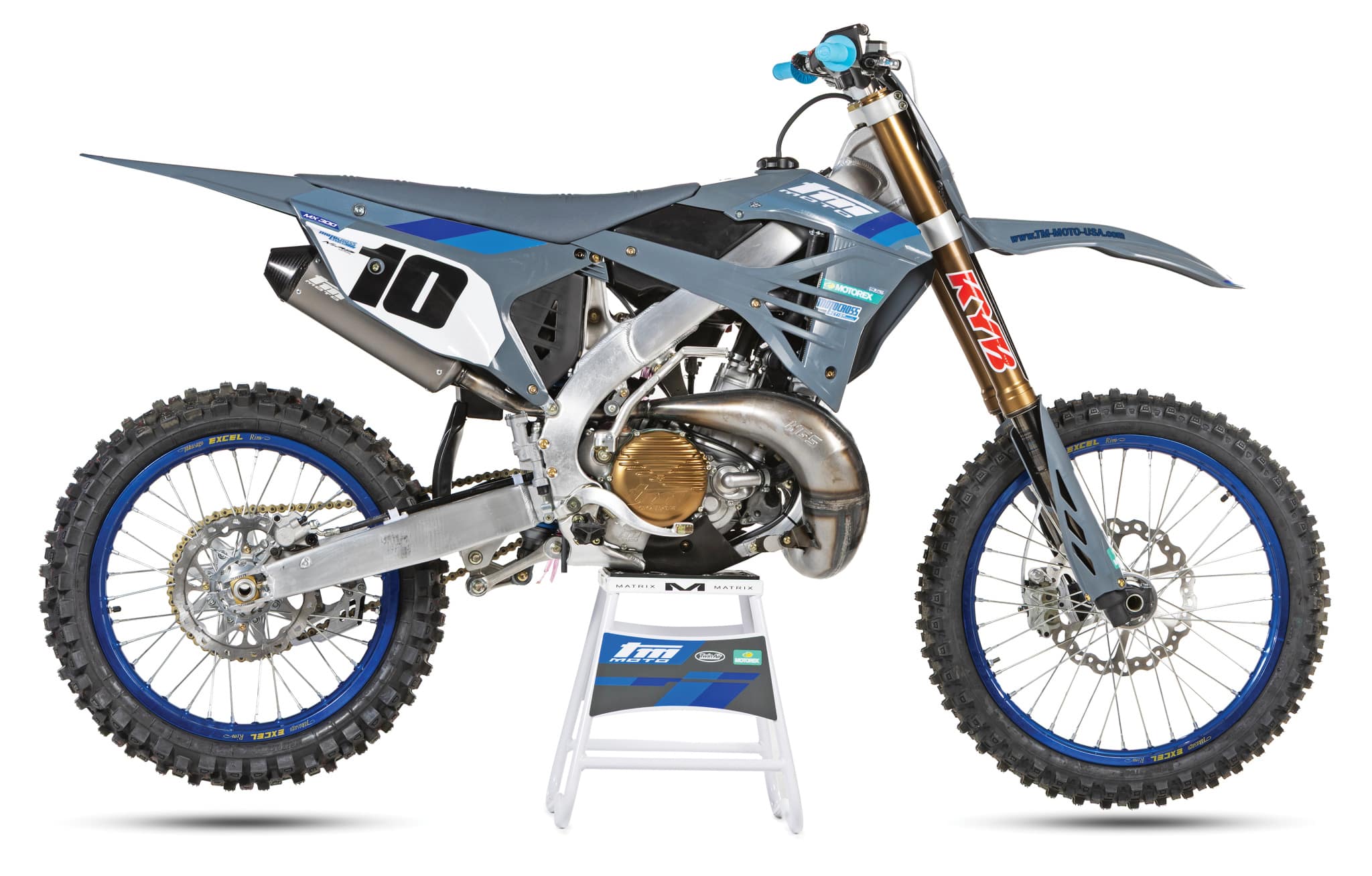 TM motorcycles are made in limited quantities. You won’t see them racing AMA Supercross or motocross, because they don’t make enough units to pass the AMA homologation rules.
TM motorcycles are made in limited quantities. You won’t see them racing AMA Supercross or motocross, because they don’t make enough units to pass the AMA homologation rules.
Q: HOW DOES THE 2025 TM 300MX RUN ON THE TRACK?
A: The powerplant is basically the same as that of the last TM 300MX we tested back in 2019—and we aren’t upset about that. Back in 2019, there weren’t any other 300cc two-strokes available in the motocross market. Of course, you could hop-up your KTM 250SX or Yamaha YZ250 with big-bore 300cc engine kits, which we’ve done multiple times, but because the 300cc two-stroke doesn’t have many classes it can race in, most OEMs opt not to make one. That is, until recently, when KTM fuel-injected its 2023 two-strokes and added a motocross-specific 300SX to its lineup, then doubled down with Husky TC300s and GasGas MC300s in 2024.
Back in 2019, we compared the TM 300MX to the hard-hitting, carbureted KTM 250SX, but now that there are fuel-injected 250cc and 300cc smokers from the Austrians, we have something to compare head-to-head to the TM 300MX.
The TM 300MX two-stroke is smooth, very smooth. It’s carbureted, but if you didn’t look down at the engine, you would think it was fuel-injected. The initial roll-on power is very confidence-inspiring (as though you had installed a Lectron carburetor). We uncrated the brand-new TM 300MX, and with the stock jetting, it was crisp and perfectly set up for Southern California conditions. Multiple test riders said that it was the best-sounding two-stroke they’ve heard in a while.
We’ve said it before, and we’ll say it again: the TM 300MX feels like a free-revving tractor. The “tractor” nomenclature refers to its luggable, linear, four-stroke-like, bottom-end character, while the “free-revving” tagline offsets any negative connotations engendered by calling a dirt bike a tractor. It doesn’t have a heavy engine feel; it snaps into the powerband with a touch of clutch work and sings like a two-stroke should—and, surprisingly, with almost zero engine braking. Yes, we know that two-strokes in general don’t have much engine braking compared to four-strokes, but the TM 300MX has noticeably less than even our comparison bikes—the KTM 300SX and Yamaha YZ250. We noticed the chain slider has a hump in the middle of it, like the new-generation CRF450s. Honda did that to optimize chain torque and promote a smoother-rolling rear wheel. This might contribute to a smoother-rolling TM 300MX rear wheel as well.
Still, the TM 300MX is unmistakably a 300. For comparison, big-bore 300cc two-strokes ride more like 500s than 250s. While the basic 250cc two-stroke likes to be screamed and revved around the track, 300cc smokers like to be short-shifted and ridden lower in the powerband. The low-end power of the TM 300MX was confidence inspiring because it didn’t hit too hard, causing it to wheelie or break traction on corner exit. This engine complements the chassis by rolling into the power in a linear and predictable fashion, helping our test riders feel comfortable riding harder than they would on other 300s. Our test riders were genuinely impressed by how creative they could get with line choices.
Q: WHAT CHANGES DID WE MAKE TO THE 2025 TM 300MX POWERPLANT?
A: This test served as a healthy reminder of how good carburetors are. The Austrian two-strokes have fixed mapping that is locked at the factory, but for $300, Twisted Development can re-map a KTM, Husky or GasGas ECU. Luckily, the carbureted TM 300MX power character could be changed around with a few quick and cheap jetting changes in the pits. The bike comes stock with a 45 pilot jet, 180 main jet, N1EH needle on the second clip from the top and a new Keihin number 7 slide. The 2019 TM 300MX came with a 6.5 slide, which was too rich. Ralf would have to replace it for us.
Thankfully, Ralf Schmidt (the previous TM USA importer) came over from Holland and joined Cam Mitchell and us for a couple test days at Glen Helen. His first recommendation was to go richer with an N1EG needle. Right away, it made noticeably more midrange power, but it didn’t help anything else. In search of more excitement down low, we tried going from a 45 to a 42 pilot, and it helped the bottom, but it also made the midrange a little too strong, which is not a bad problem to have. From there, we left the 180 main jet and went from a 49- to a 48-tooth rear sprocket.
Ralf and Cam brought a few silencer options to test as well. TM Italy works with HGS exhausts from Holland, and the stock silencer that comes on the TM 300MX looks trick, but it’s on the short side for a 300cc powerband. We tried the long HGS silencer that comes stock on the EN300 model, and we tried the aftermarket HGS Enduro silencer, which is longer than stock but not as long as the Enduro silencer. Our test riders chose the aftermarket silencer as the winner. The carb changes boosted the TM 300MX’s midrange power, and the longer silencer helped broaden the power window, which was a huge benefit. Even with the changes, the TM 300MX is still not a third-gear bike. But, we knew that from the start, which is why going down to a 48-tooth sprocket made sense, because it helped the second gear pull farther.
Q: HOW DOES THE 2025 TM 300MX TWO-STROKE HANDLE ON THE TRACK?
A: The 2025 TM 300MX is sprung pretty light with 4.4 springs in the front and a 4.8 spring in the rear. And, as mentioned, our bike came with the upgraded Kayaba A-kit forks, which have uniquely different valving from the stock forks. On the track, the TM 300MX suspension was soft at the top of the stroke, and it got stiffer, as expected, deeper in the stroke. Our faster riders ended up in the harsh spot more often with the stock setting, while our novice, intermediate and vet test riders were able to find comfort with the stock spring rates.
Cornering is exceptional on the TM. In the past, the exotic Italian brand was known for having a stink-bug chassis, but not anymore. Thanks to great front-end traction, our test riders leaned into corners with confidence and were able to switch lines with ease. The bike was very stable at high speeds as well. Our testers labeled the TM 300MX a front-end steering bike, but they mentioned that it was balanced enough to steer with the rear, too.
Q: HOW DOES THE 2025 TM 300MX COMPARE TO THE 2025 KTM 300SX?
A: KTM has been making off-road-specific 300cc two-strokes for a while, and we knew it would be a success when they introduced their 300SX motocross model, because so many vet riders, professional practice riders and Open two-stroke racing pros have been boring out 250 two-strokes into 300s for years. With TM and the three Austrian bikes, there are four manufacturers in this race, and soon Kawasaki will be joining them. Kawasaki has already publicly announced its return to the two-stroke world, and we’ve heard through reliable sources that it’ll be a 300cc motocrosser.
We made sure to have our 2025 KTM 300SX on standby throughout this entire test, just to keep checking our TM 300MX against the current standard in our industry. Let’s break down the differences between the KTM and TM into four points:
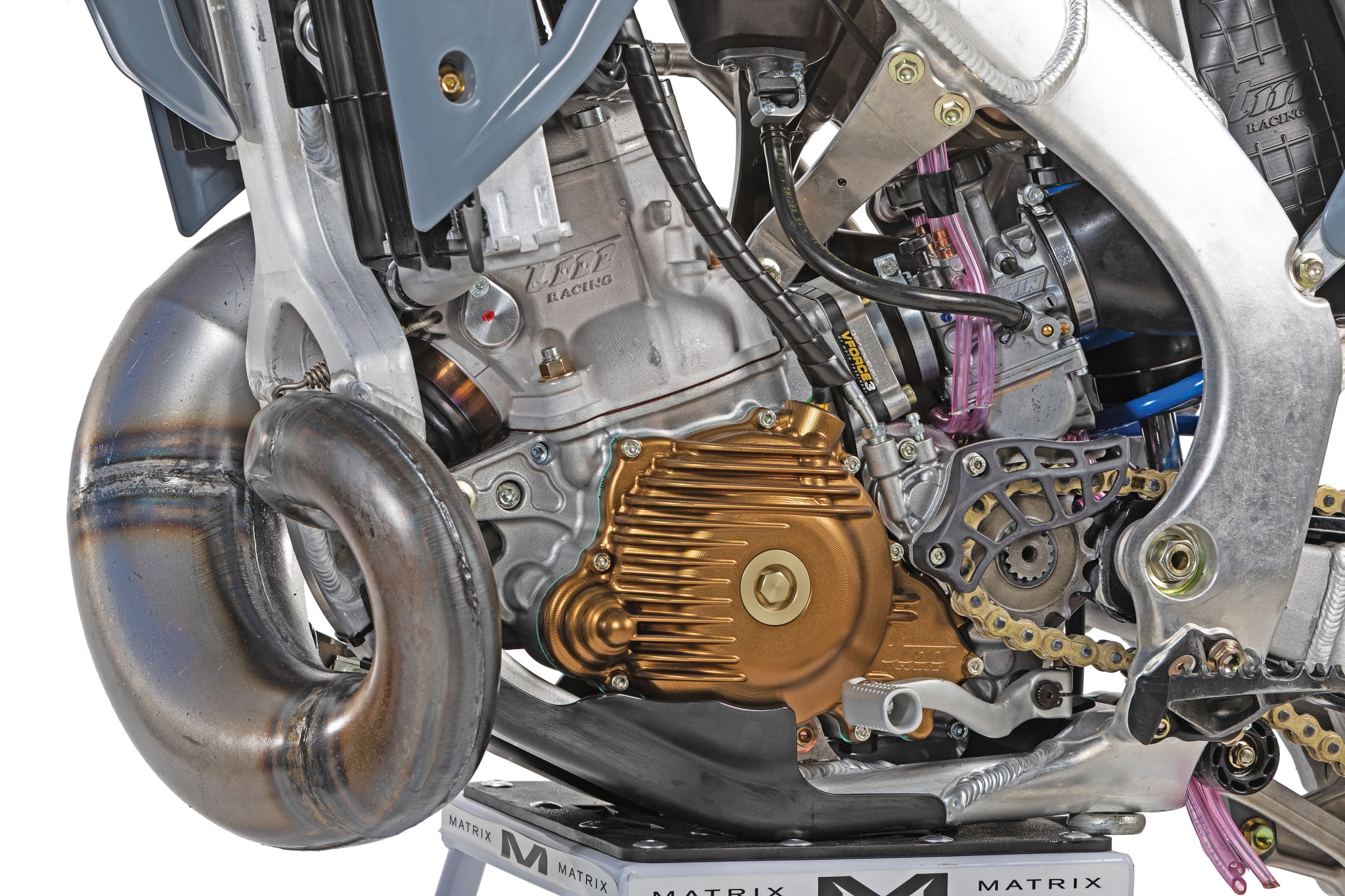 The CNC-machined ignition cover is an upgraded part ordered from TM.
The CNC-machined ignition cover is an upgraded part ordered from TM.
(1) Ergos. Starting with the first impression, the TM 300MX has a comfortable cockpit, but surprisingly, the handlebars are on the low side compared to other stock bikes. We like KTM’s ergonomics, and compared to the TM, the orange bike’s bars were taller and wider. The TM plastics were great. The plastic looks unique, unlike any other bike on the market, and it fit well. Our test riders had no issues gripping the bikes and no areas where their boots snagged on the plastics.
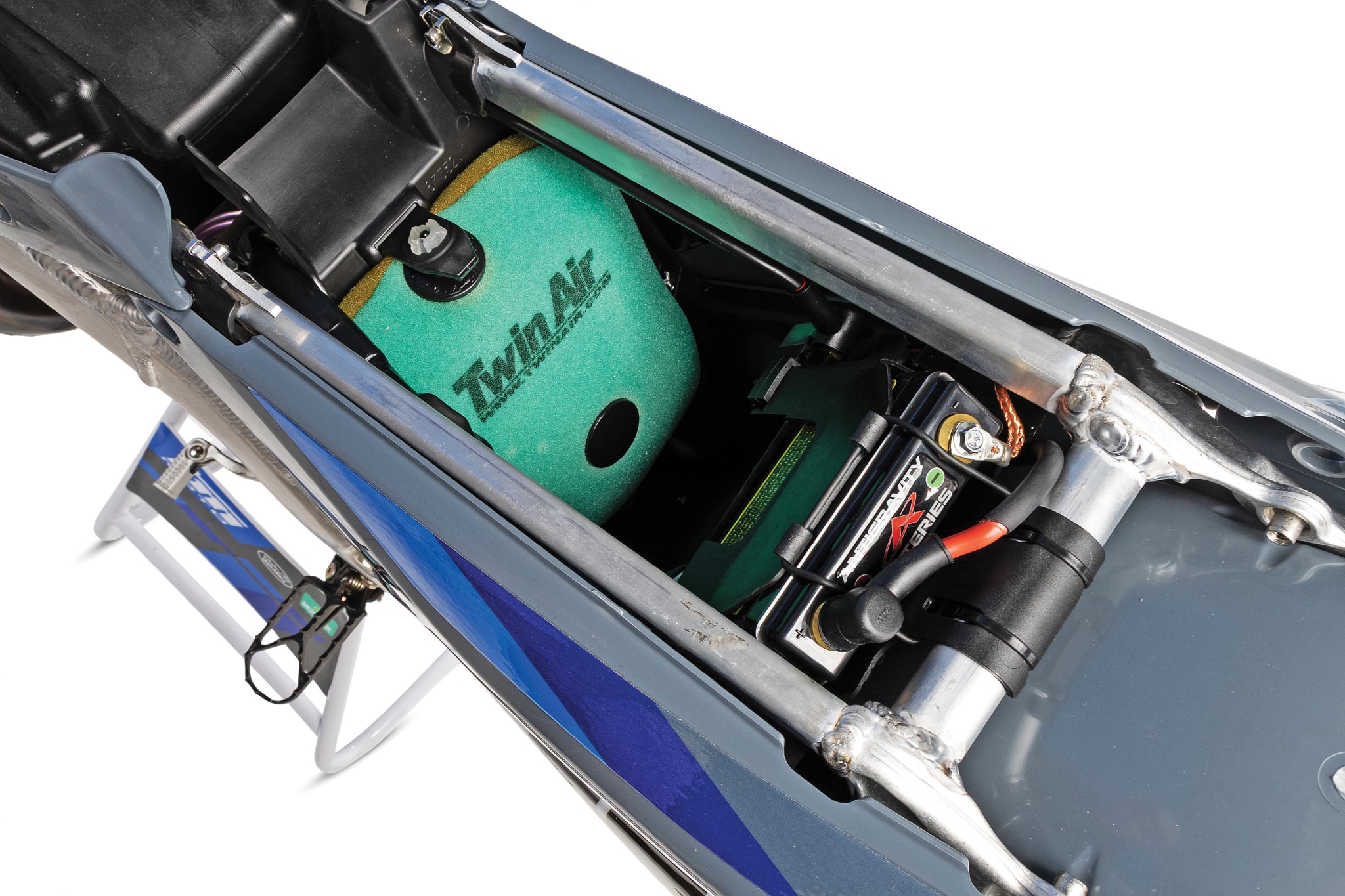 The Twin Air filter and battery from above.
The Twin Air filter and battery from above.
(2) Power. Since KTM ditched the carburetor and spring-loaded power valve for electronic fuel injection and an electronic power valve, the engine character became smoother on the bottom end, which we determined was more four-stroke-esque. The TM 300MX, with a carburetor and an electronic power valve, has the same friendly roll-on power. The KTM 300SX was faster and more exciting than the TM 300MX. The orange bike hit harder and pulled third gear effortlessly in some corners, while the TM 300MX lacked the grunt to pull third. The KTM engine is faster, but the TM 300MX is easier to hold onto for a longer moto. Our test riders felt the TM 300MX was better for a wider range of riders, while the KTM 300SX’s power needed to be respected more.
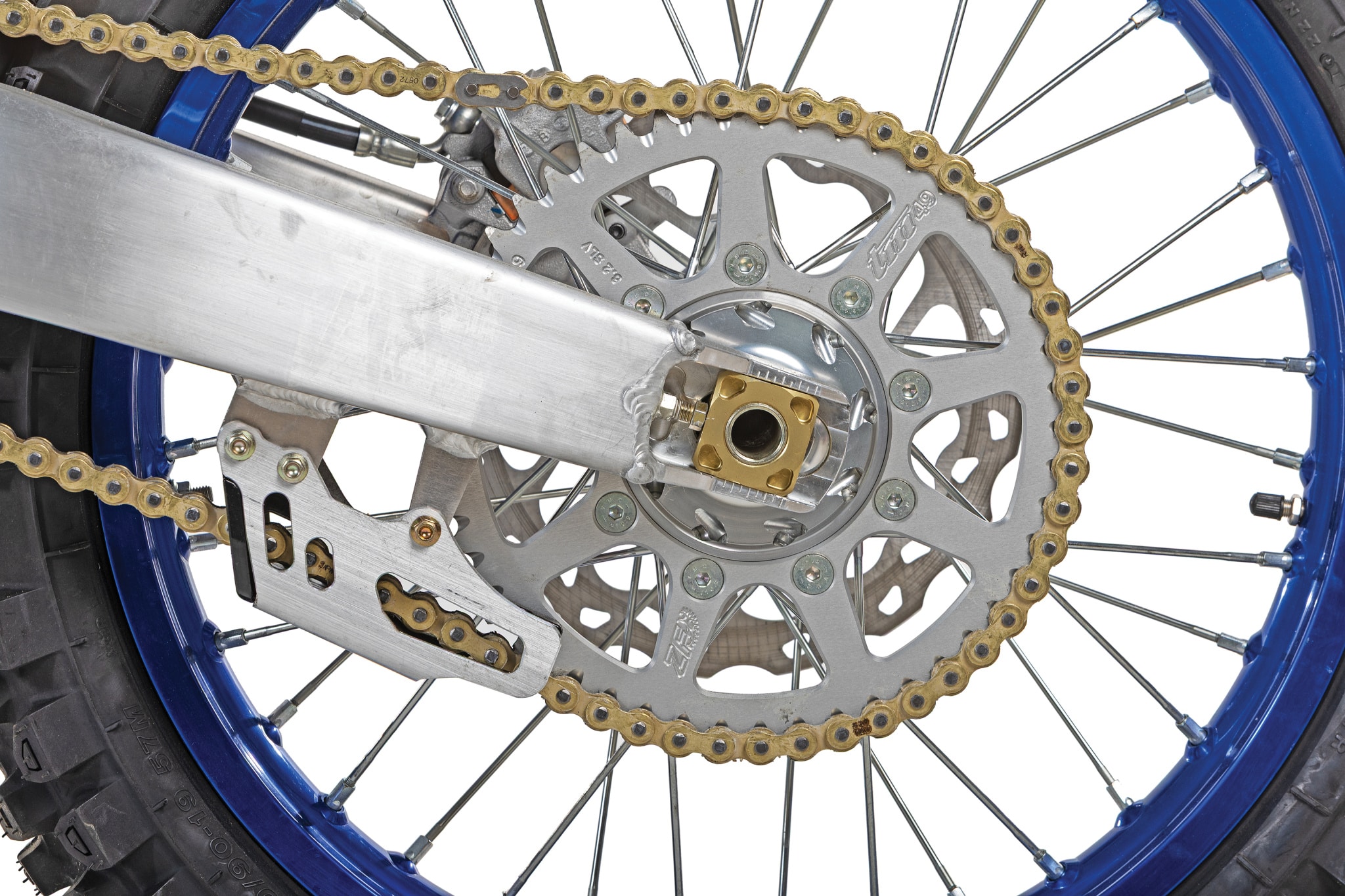 Nine-bolt sprocket.
Nine-bolt sprocket.
(3) Handling. The KTM 300SX hops, skips and jumps around the track in a good way. It feels light and nimble. With the WP air forks and chromoly steel frame, it’s a very lively bike. With its aluminum frame and Kayaba A-kit coil-spring forks, the TM 300MX felt heavier, less reactive, and more planted to the ground. Most of our test riders preferred the KTM’s chassis, but the TM got better the more we worked on the suspension settings.
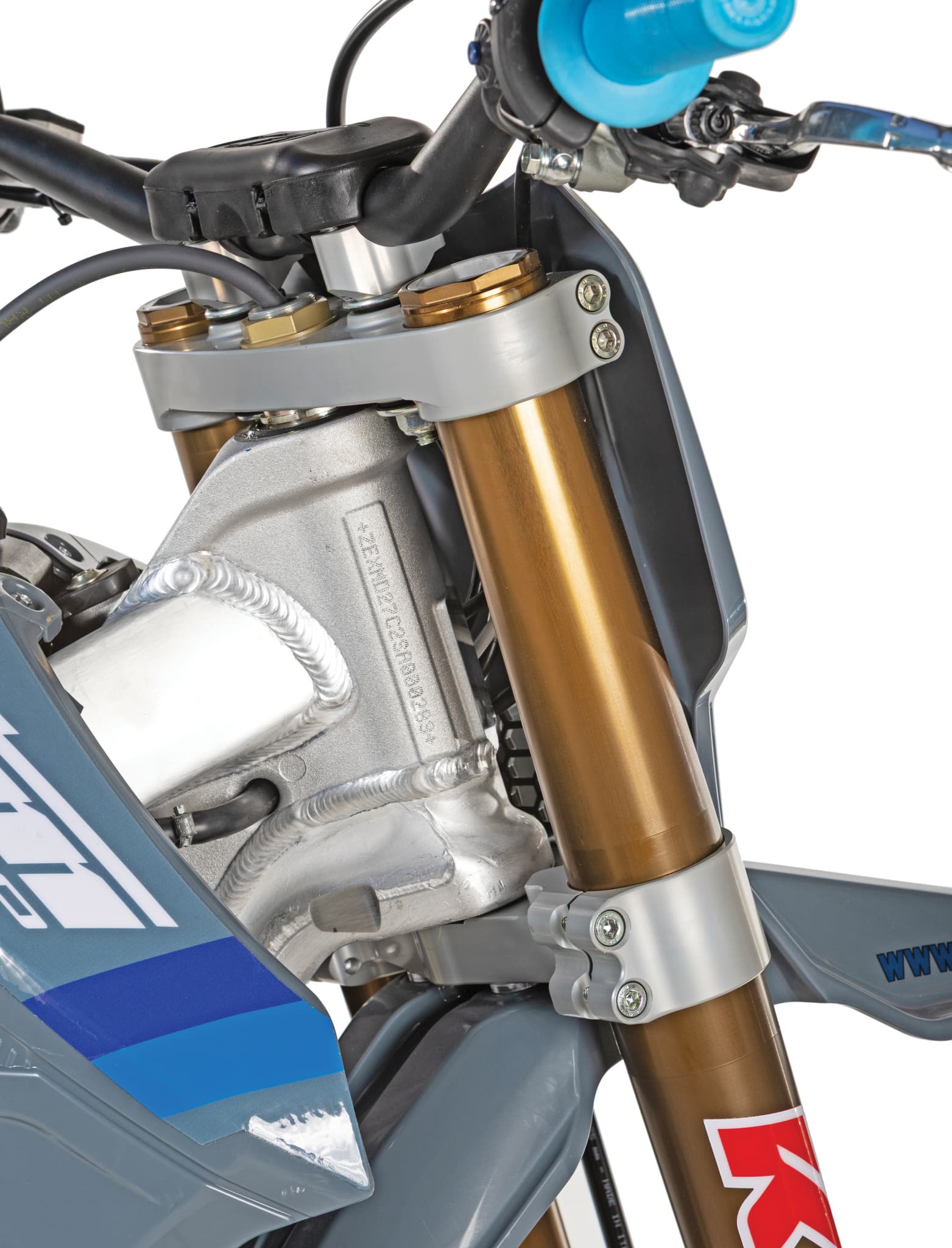 These top clamps and bar mounts aren’t stock, and are an extra $185.
These top clamps and bar mounts aren’t stock, and are an extra $185.
(4) Maintenance. We can’t compare these bikes without stating the obvious. Carbureted bikes are easier to work on and easier to modify. We wish KTM would take a page out of TM’s book and give the consumer both options. TM makes a fuel-injected 300MX, and it’s only $150 more ($10,545). That’s the benefit of being a boutique brand. You can find holes in the market and offer multiple options without producing mass quantities. KTM is too big to do that.
Q: WHAT DID WE HATE?
A: The hate list.
(1) Tires. The biggest downside of the Bridgestone Battlecross X31 tires is braking. The rear tire doesn’t hold its line well when you’re decelerating; however, we were impressed with the front-tire traction.
(2) Grips. The Electric Blue Circuit grips look cool, but they are really hard.
(3) Allen. We don’t know who Allen is, but we wish TM wouldn’t have used his bolts throughout this bike. We prefer hex-head bolts.
(4) Vibration. The hand feel wasn’t terrible, but vibration through the footpegs is more than we like.
(5) Sprocket bolts. We have always complained about the nine-bolt rear sprockets on TMs. It still feels excessive and looks weird, but at least now we understand why they do it. You can access the nuts straight on with a ratchet and an extension instead of battling against spokes to squeeze a wrench in there.
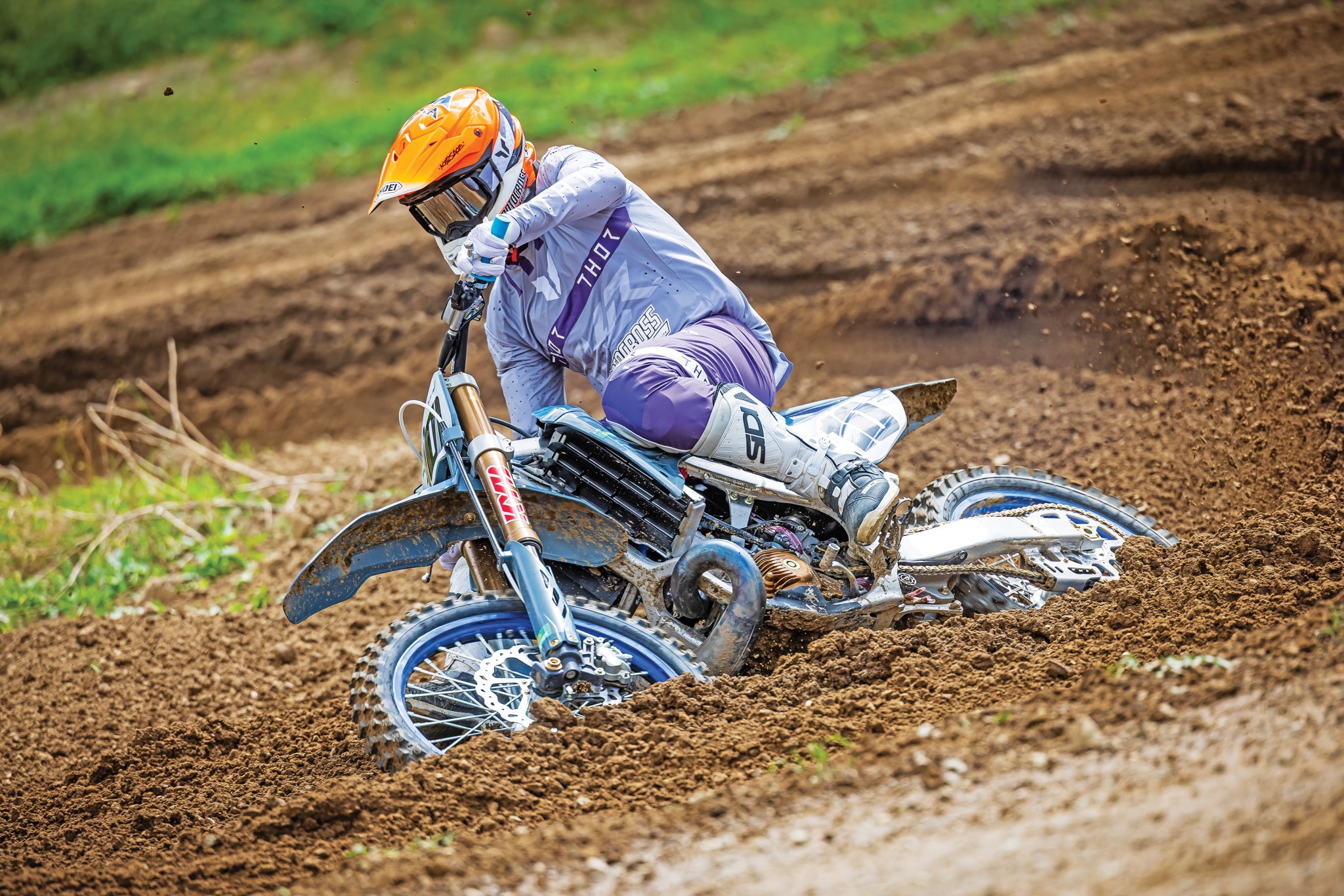 Our testers loved how predictable and consistent the front end was on the TM 300MX.
Our testers loved how predictable and consistent the front end was on the TM 300MX.
Q: WHAT DID WE LIKE?
A: The like list.
(1) Engine. It’s not the fastest 300cc offering, but this engine is smooth and confidence-inspiring.
(2) Style. The plastics make the TM stand out from the crowd. Even though we don’t love the dull look of grey plastics, we can’t blame TM too much for trying to be different. The front number plate is vented as well, and Cam Mitchell explained that it’s not just for show. Since the airbox cover doesn’t have any holes in it, there are vents above the radiators that help channel air into the airbox, and the vented front number plate helps flow more air in that direction.
(3) Quality. We like the extra attention to detail that TM puts into their bikes. The stator wire, hydraulic clutch line, gear position wire, and other wires were all wrapped up and protected nicely. The amateur engineers of the MXA wrecking crew called it “sano.” Other, much bigger manufacturers don’t pay the same attention to detail when it comes to wire management.
(4) Options. It’s cool that you can customize your TM when ordering it. The downside to ordering a TM is that it takes five to six weeks for it to be air-freighted over from Italy. There are dealers in the U.S. again now, but because TM is such a small brand, they don’t keep many bikes in stock.
(5) Brakes. The Brembo front and Nissin rear worked well.
Q: WHAT DID WE REALLY THINK?
A: The TM 300MX is tailor-made for its target audience—riders who want to stand out from the crowd. The 300cc two-stroke is perfect for vet riders and Open two-stroke riders. In the past, TMs needed a lot of help to be competitive, and Dutchman Ralf Schmidt worked tirelessly to Americanize the bikes and make them comfortable for American riders. TM’s two-stroke engines have been good for a while, but their chassis needed work. The Italians will never admit it, but they’ve taken Ralf’s advice on the American chassis setup. Now it is competitive. This is the first year that an MXA test rider has requested to race a TM at the famously rough Wiseco World Two-Stroke Championships at Glen Helen (read about it on page 80). Josh Fout could have raced MXA’s KTM 300SX or Husky TC250, but after racing the Husky TC250 and TM 300MX in multiple events leading up to the race, he decided to line up on the TM 300MX for the “big show.”


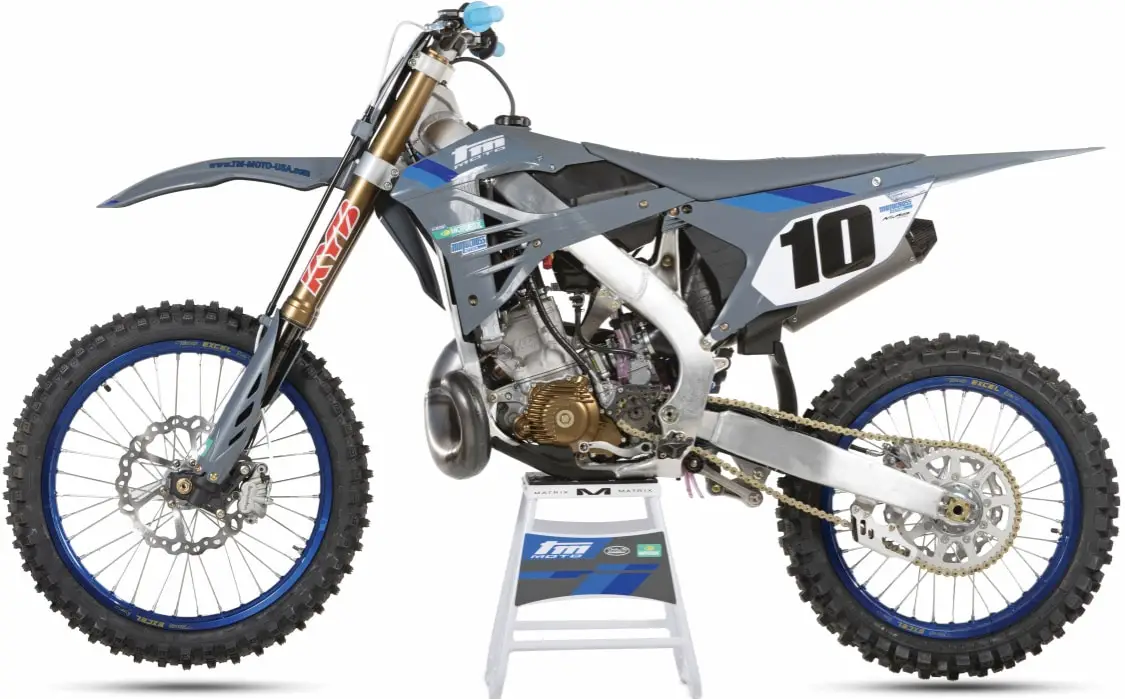
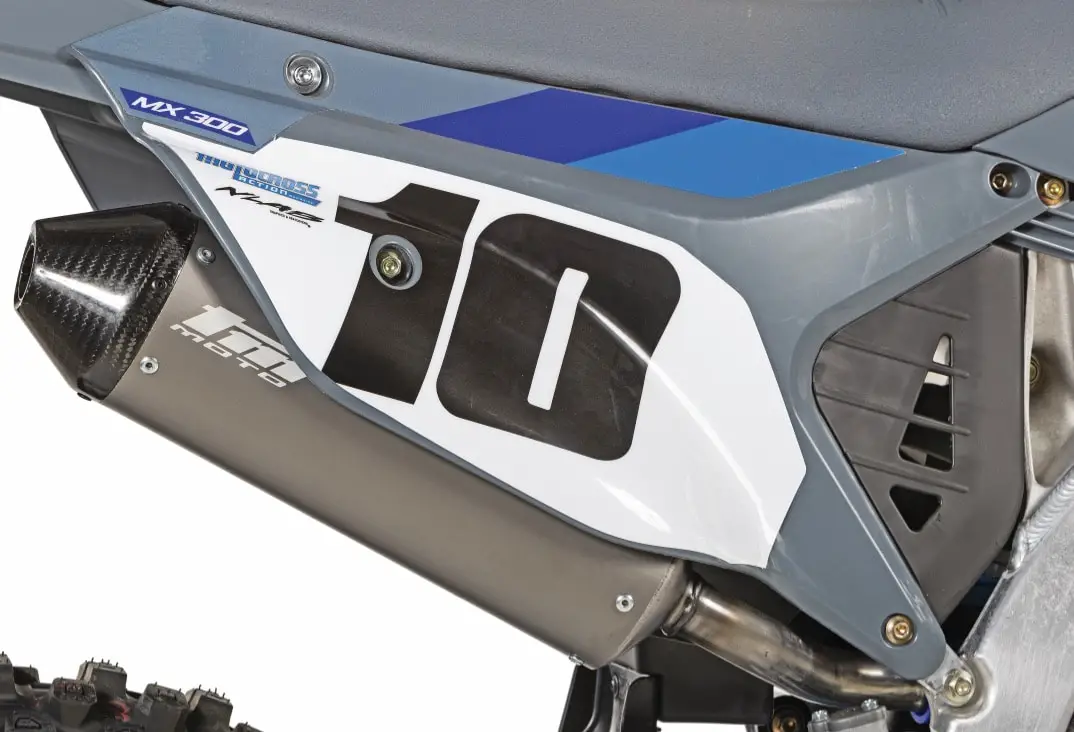

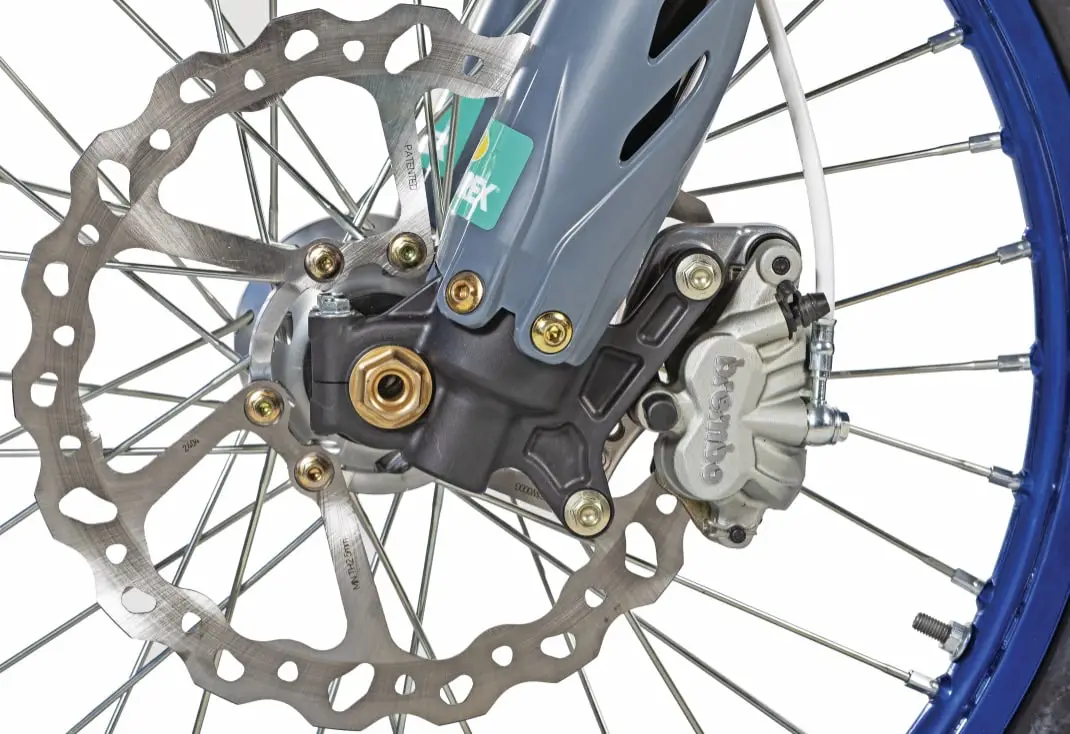
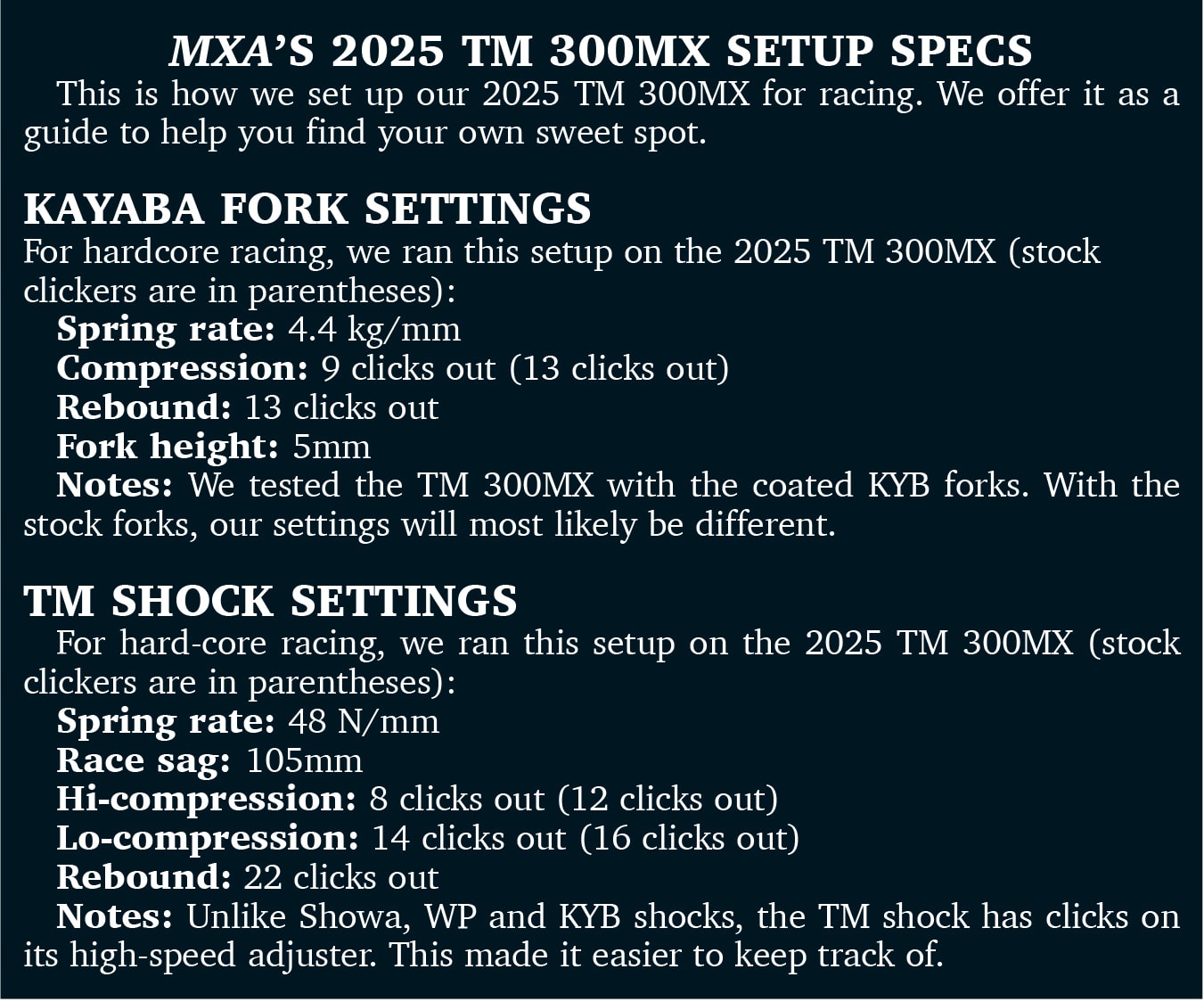

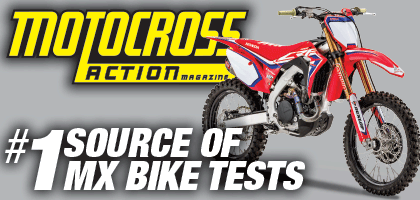


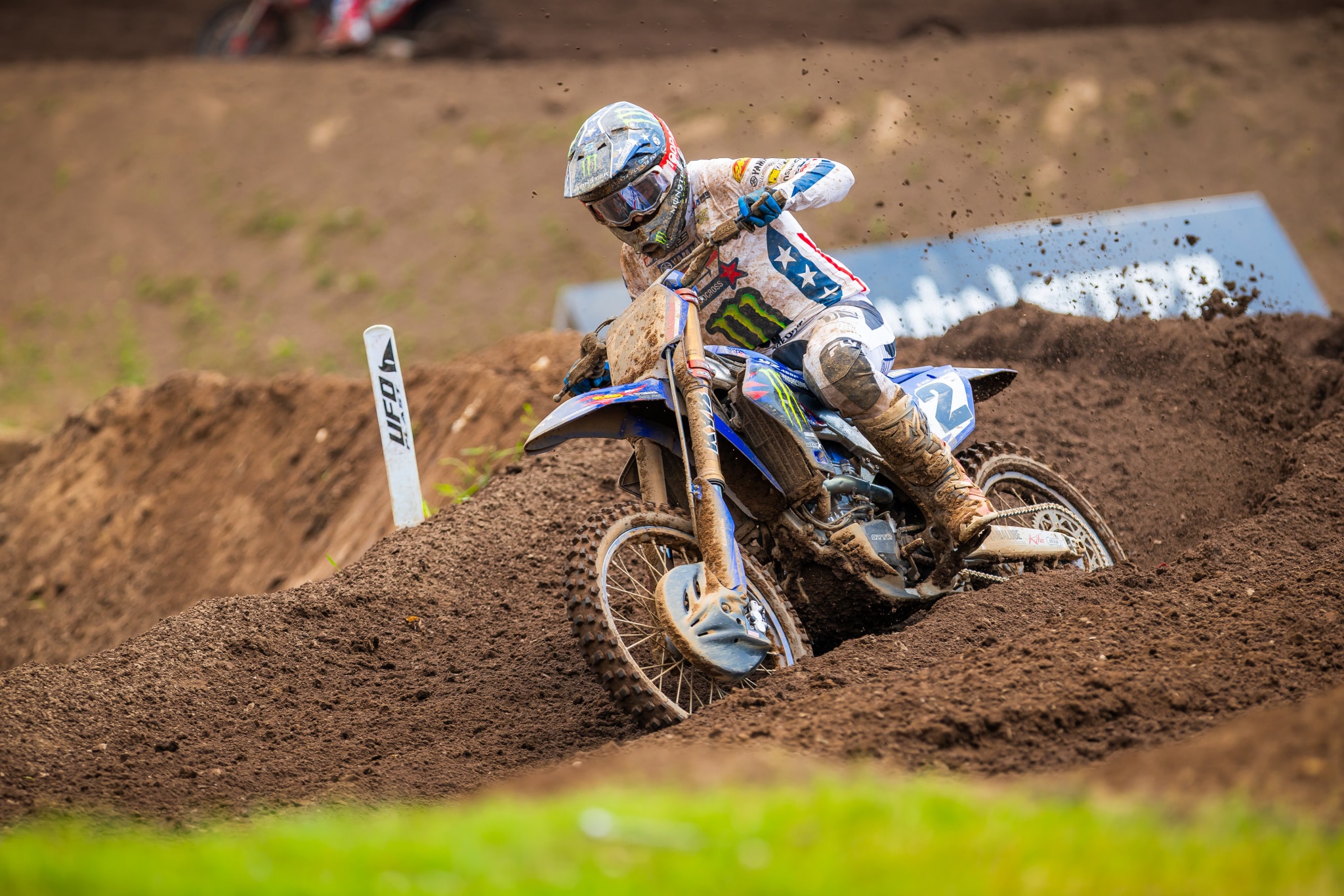

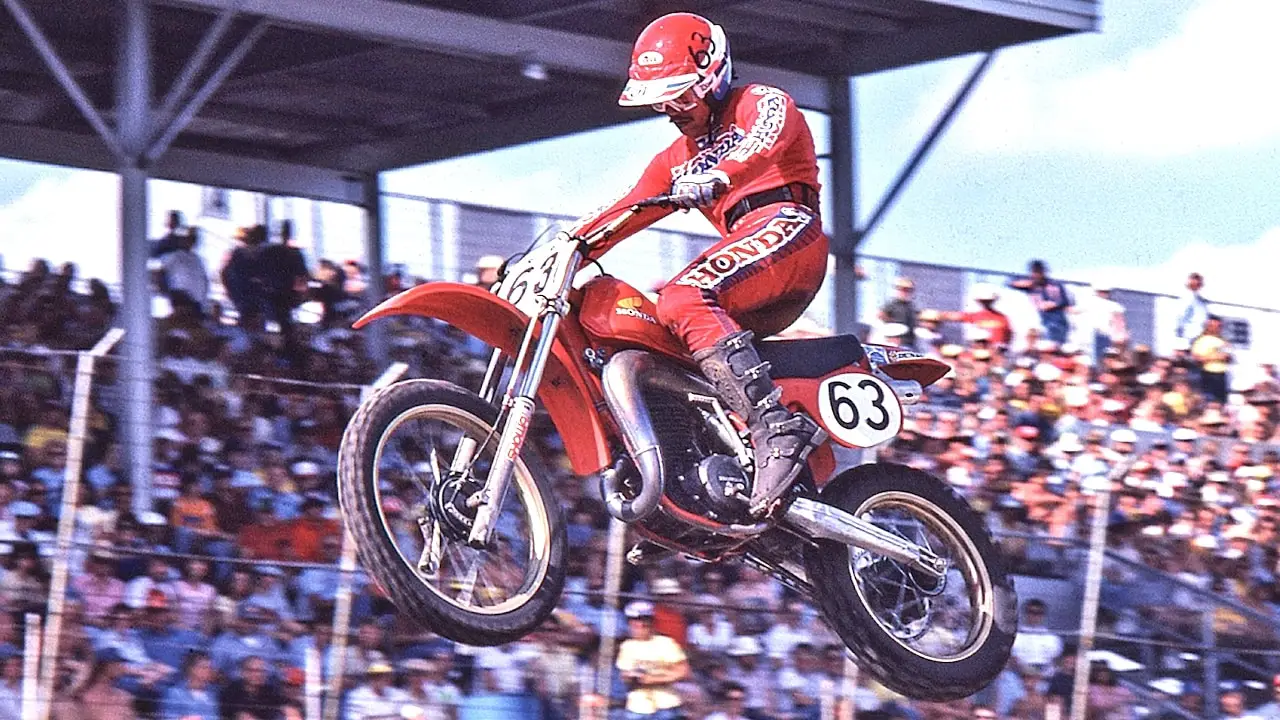












 English (US) ·
English (US) ·  French (CA) ·
French (CA) ·